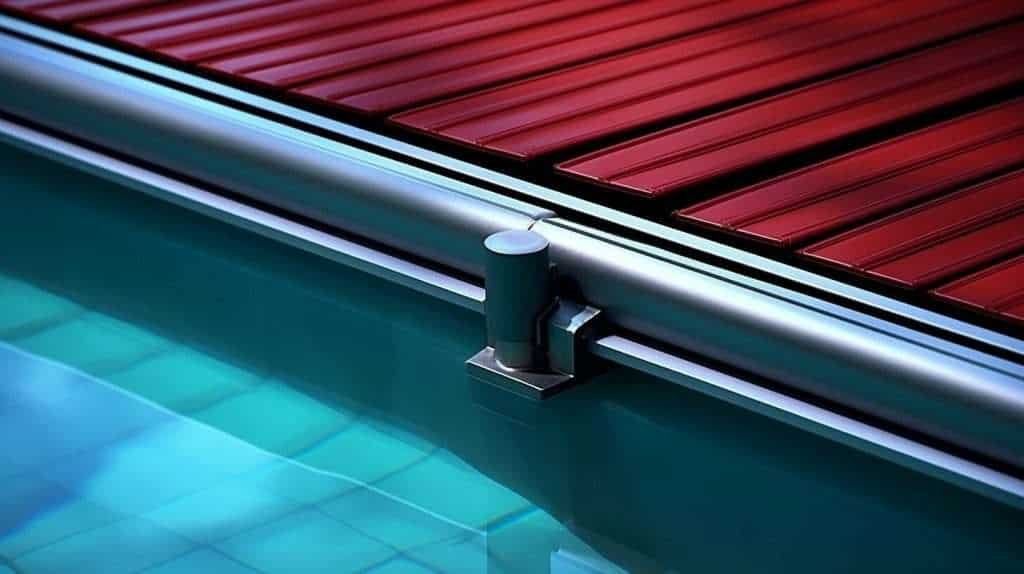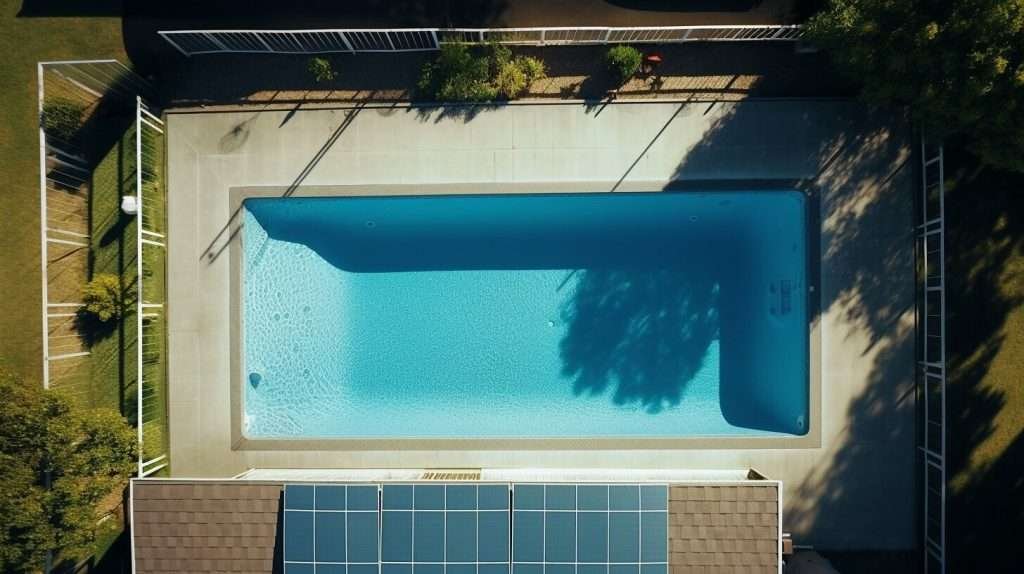Welcome to my ultimate guide to pool safety. As a professional copywriting journalist, I have seen firsthand the devastating effects of pool accidents. That’s why I want to stress the importance of pool safety, and one of the most effective measures you can take to prevent accidents: using a pool cover.
Many pool owners wonder, “Are pool covers safe?” The answer is a resounding yes, as long as they are used properly and meet all safety standards. In this guide, we will explore the different types of pool covers available, safety standards they should meet, benefits of using them, and how to install and maintain them to ensure their safety features. By understanding the importance of a pool cover and taking the necessary precautions, you can effectively safeguard your pool and provide a layer of protection for your family and pets. Whether you choose a mesh, solid, or automatic cover, it is essential to follow installation and maintenance guidelines to ensure maximum safety. With the right precautions in place, pool covers can offer peace of mind and added security for your pool area.
Key Takeaways:
- Pool safety is crucial to prevent accidents.
- Using a pool cover is an effective safety measure.
- Pool covers are safe if used properly and meet safety standards.
Understanding the Different Types of Pool Covers
When it comes to choosing a pool cover, there are several options available that cater to different safety needs, budgets, and pool types. Understanding the features and benefits of each type can help you make an informed decision and ensure maximum safety for your pool.
Safety Covers
Safety covers are designed to prevent accidental drowning and are an ideal choice for families with children and pets. They are made of durable materials such as vinyl or mesh and are anchored to the pool deck using straps and springs. Safety covers are available in various shapes and sizes and can withstand heavy loads, making them suitable for winter use.
When choosing a safety cover, look for one that meets industry safety standards such as the ASTM International Standard F1346-91 or the Safety Cover Institute (SCI) guidelines. These standards ensure that the cover is strong enough to withstand the weight of people or pets that may accidentally fall into the pool.
Solar Covers
Solar covers, also known as bubble covers or thermal blankets, are designed to harness the power of the sun to keep pool water warm. They are made of lightweight, UV-resistant material and have numerous air bubbles that trap and retain heat. Solar covers are easy to install and remove and help reduce evaporation and chemical loss.
Solar covers are not safety covers and cannot support the weight of a person. However, they can be used in conjunction with a safety cover to provide added protection and energy-saving benefits.
Automatic Covers
Automatic covers, also known as electric covers, are the priciest but most convenient type of pool cover. They are operated by a motor that retract and extends the cover over the pool, eliminating the need for manual labor. Automatic covers are available in different models such as under-track, top-track, and hybrid and can be customized to fit any pool shape and size.
Automatic covers can provide both safety and energy-saving benefits. They prevent access to the pool when not in use and reduce heat loss, evaporation, and chemical consumption. However, they require regular maintenance and should only be installed by a professional.

Regardless of the type of pool cover you choose, ensure it is properly installed, maintained, and used in accordance with safety guidelines and regulations. Always supervise children and pets around the pool area and take additional safety measures such as installing fences, alarms, or pool safety nets.
Safety Standards for Pool Covers
When it comes to pool covers, safety should always be a top priority. Whether you are a pool owner or a manufacturer, it is essential to understand the safety standards that pool covers must adhere to in order to minimize the risk of accidents and ensure reliable protection.
There are several safety measures that pool covers should meet, including industry regulations, certifications, and guidelines. The American Society for Testing and Materials (ASTM) has set specific safety standards for pool covers to ensure they provide adequate protection against drowning and entrapment.
One of the key safety standards is the ASTM F1346-91 standard. This standard sets guidelines for pool covers to ensure they can support a certain amount of weight without collapsing, and to prevent small children from slipping under the cover and into the pool. Additionally, pool covers should have a locking mechanism that is easy to use and prevents unauthorized access.
Another significant standard is the ASTM F2036-16 standard, which covers pool safety cover components, such as anchors and fasteners, and their performance requirements. This standard has a specific focus on preventing children from gaining access to the pool through gaps in the cover or around the pool’s edge.
It is essential to ensure that pool covers meet all applicable standards, such as these ASTM standards, before purchasing them. Moreover, it is important to regularly inspect pool covers to ensure they are in good condition and still meet safety standards. This will help you maintain a safe and secure pool environment.

Benefits of Pool Covers for Safety
Using a pool cover is an effective safety measure for your pool that offers many benefits beyond accident prevention. Here are some of the advantages of using a pool cover:
- Prevents Accidents: The primary benefit of using a pool cover is to reduce the risk of accidents, particularly for children and pets. A pool cover acts as a barrier to prevent unauthorized access to the pool area.
- Conserves Water: By covering your pool, you can reduce water evaporation, which can lower your water bill and help conserve resources.
- Maintains Water Quality: A pool cover helps keep debris out of the pool, which means less time and money spent on cleaning and maintenance.
- Increases Energy Efficiency: A pool cover can help insulate your pool, reducing heat loss and saving energy by minimizing the amount of heat needed to maintain the pool temperature.
- Protects Your Investment: A pool cover can extend the life of your pool by reducing the exposure to harmful UV rays, chemicals, and debris.
Overall, a pool cover is a cost-effective and practical safety measure that offers significant benefits beyond accident prevention. It can help reduce energy and water consumption, cut down on maintenance costs, and protect your pool investment.

Installing and Using Pool Covers Safely
Proper installation and usage of pool covers are critical to ensure their safety features. Here are some guidelines to follow:
Anchoring and Securing Mechanisms
Ensure that the pool cover is anchored and secured tightly to prevent any gaps or openings. Any loose spots or areas that have not been secured could be potential hazards. Use a pool cover that comes with a tensioning system and locking mechanisms to keep it in place.
Maintenance and Regular Inspections
Regularly inspect the pool cover for any wear and tear, and ensure that it is in good condition. Replace any damaged parts or replace the entire cover if necessary. Remove any debris such as leaves or branches from the top of the cover to prevent it from accumulating and weighing down the cover, potentially causing it to cave in.
Pool Cover Removal
When removing the pool cover, make sure to fold it correctly and store it away properly. Avoid dragging it across rough surfaces or exposing it to direct sunlight for extended periods of time.

Remember, pool covers are not a substitute for adult supervision. Ensure that the pool is never left unattended, and that children are always supervised while in or around the pool.
Safely Maintaining Your Pool Cover
Proper maintenance and care are essential to ensure your pool cover remains safe and effective. Regular cleaning, repair and storage will extend the lifespan of your cover and maintain its safety features. Here are some tips to help you maintain your pool cover:
- Clean your pool cover regularly: remove debris and dirt to prevent it from accumulating and weighing down the cover. Use a soft brush to gently scrub the surface and rinse thoroughly with a hose. Avoid using harsh chemicals or cleaners that may damage the cover.
- Inspect your pool cover for damages: check for any tears, holes, or worn-out areas that may compromise the cover’s safety. Repair or replace damaged covers immediately, before water or debris can infiltrate the pool.
- Store your pool cover properly: when not in use, keep your cover in a dry and cool place, away from direct sunlight or heat. Fold it carefully to avoid creases or folds that may cause damage over time.
By following these guidelines, you can maintain the safety and effectiveness of your pool cover for years to come.

Tip: If you’re not comfortable or experienced with cleaning or repairing pool covers, consider hiring a professional pool service to handle it for you. They have the specialized knowledge and tools to ensure your cover remains safe and functional.
Additional Pool Safety Measures
While pool covers are an essential safety measure for any pool owner, they should not be the only one. Layering safety measures is crucial to ensure the maximum protection for swimmers. In addition to using pool covers, here are some other safety measures that you should consider:
- Fencing: Installing a fence around your pool is an effective way to keep children and pets out of the pool area when it is not in use. The fence should be at least four feet high and have a self-closing, self-latching gate.
- Alarms: Pool alarms are designed to alert you if someone or something enters the pool without your knowledge. There are different types of alarms available, such as surface alarms, sub-surface alarms, and perimeter alarms. Consult with a pool safety expert to determine which type of alarm is best for your pool.
- Supervision: Never leave children or inexperienced swimmers unattended near the pool, even if a pool cover is in use. Designate a responsible adult to supervise the pool area during pool use, and ensure that they know basic CPR and first aid.
Remember, incorporating multiple safety measures is key to creating a secure pool environment that can prevent accidents or injuries. By following these tips and installing additional safety measures, you can enjoy peace of mind and a worry-free swimming experience.

Common Misconceptions about Pool Covers and Safety
As an experienced journalist covering pool safety, I have come across several common misconceptions and myths about pool covers. It is essential to debunk these false beliefs to promote proper pool safety measures and prevent accidents.
- Myth: Any type of pool cover is suitable for safety.
Fact: Not all pool covers are created equal when it comes to safety. Only covers that meet safety standards and guidelines should be used for this purpose. It is crucial to research and choose a pool cover that is specifically designed for safety and meets industry regulations.
- Myth: Pool covers can replace pool fences and other safety measures.
Fact: Pool covers should not be considered a replacement for other safety measures, such as pool fences, alarms, and supervision. Layering safety measures is the best way to ensure pool safety and prevent accidents.
- Myth: Pool covers are only necessary for families with children.
Fact: Pool covers are essential for any pool owner, regardless of whether there are children in the household or not. They help prevent accidents, conserve water, and maintain water quality, among other benefits.
- Myth: Any person can install and use a pool cover safely.
Fact: Proper installation and use of a pool cover require certain skills and knowledge. It is recommended to hire a professional to install the cover or follow the manufacturer’s instructions carefully. Regular maintenance, anchoring, and securing mechanisms are also crucial for ensuring the cover is used safely and effectively.
- Myth: Pool covers are a one-time investment.
Fact: Pool covers require regular maintenance and care to ensure their safety features are maintained. They also need to be replaced periodically due to wear and tear. It is essential to factor in these costs when investing in a pool cover.
By understanding the truth behind these common misconceptions, pool owners can make informed decisions to ensure the safety of their loved ones.

Pool Covers and Legal Obligations
As a pool owner, it is important to be aware of the legal obligations related to pool cover safety. These may include local regulations and building codes that mandate the use of certain types of pool covers or safety measures to prevent accidents.
Failing to comply with these regulations could result in fines or penalties, and potentially even legal action in the event of an accident. It is essential to research and understand the legal obligations in your area to ensure the safety of your pool users and avoid any legal repercussions.
Additionally, adhering to industry safety standards and certifications is crucial in selecting and installing pool covers that meet the necessary safety requirements. By doing so, you can have peace of mind knowing that your pool cover is reliable and secure, and that you have taken the necessary steps to provide a safe swimming environment for your family and guests.

Image source: https://seowriting.ai/32_6.png
Educating Your Family about Pool Cover Safety
As a pool owner, it’s your responsibility to ensure that your family, especially children, are aware of the safety measures in and around the pool. Educating them about proper pool cover usage is an important step in maintaining a safe pool environment. Here are some tips to help you teach your family about pool covers safety:
- Explain the purpose of the pool cover: Start by explaining why you use a pool cover. Emphasize the importance of preventing accidents and keeping the pool clean and well-maintained.
- Demonstrate proper usage: Show your family how to properly install and remove the pool cover. Make sure they understand how to secure the cover in place and how to release it safely.
- Establish pool safety rules: Set clear rules for pool usage, including requiring the use of the pool cover when the pool is not in use. Make sure everyone in the family understands the consequences of not following these rules.
- Supervise children: Never leave children unsupervised near the pool, even if the pool cover is in place. Always keep a watchful eye on children when they are in or near the pool.
- Practice regular safety drills: Conduct regular safety drills with your family, including how to respond in an emergency situation. Make sure everyone knows how to call for help and perform basic first aid.
Remember, pool cover safety is a shared responsibility. By educating your family about pool cover safety, you can help create a safe and enjoyable pool environment for everyone.

In Conclusion: Pool Covers and Peace of Mind
In conclusion, pool covers are an essential safety measure for any pool owner. By preventing accidents, protecting children and pets, conserving water, and maintaining water quality, pool covers provide peace of mind and security.It is important to choose the right type of pool cover and ensure that it meets safety standards and regulations. Proper installation, maintenance, and care are also crucial factors in ensuring the effectiveness of pool covers in preventing accidents.In addition to using pool covers, layering safety measures such as fencing, alarms, and supervision can further enhance pool safety. Educating family members, especially children, on pool cover safety rules and guidelines is also essential for creating a secure pool environment.By taking these steps to ensure pool safety, pool owners can enjoy their pools with peace of mind, knowing they have taken every precaution to prevent accidents.What are the Steps to Maintaining a Swimming Pool Cover?
Maintaining a swimming pool cover is essential for optimal functionality and durability. Here are a few crucial beginner swimming pool maintenance tips for keeping your cover in top shape. Firstly, regularly remove debris and leaves accumulated on the cover’s surface. Next, make sure the cover is properly installed, avoiding any sagging or overstretching. Additionally, clean the cover with mild detergent and a soft brush to remove dirt and stains. Lastly, store the cover in a dry area when not in use, preventing any moisture-related damage.
FAQ
Q: Are pool covers safe?
A: Yes, pool covers are an important safety measure for pools. They help prevent accidents and provide peace of mind for pool owners.
Q: What are the different types of pool covers?
A: There are various types of pool covers available, including mesh covers, solid covers, and automatic covers. Each type has its own features and benefits.
Q: What safety standards should pool covers meet?
A: Pool covers should meet industry regulations and guidelines to ensure maximum safety. These standards include proper anchoring, secure mechanisms, and certifications.
Q: What are the benefits of using pool covers for safety?
A: Pool covers help prevent accidents, protect children and pets, conserve water, and maintain water quality. They offer numerous advantages for pool owners.
Q: How do I install and use pool covers safely?
A: Proper installation and usage of pool covers involve anchoring, securing mechanisms, regular maintenance, and inspections to ensure effectiveness in preventing accidents.
Q: How do I maintain and care for pool covers?
A: Regular cleaning, repairing, and proper storage of pool covers are important for maintaining their safety features and prolonging their lifespan.
Q: What other safety measures should I take with pool covers?
A: In addition to using pool covers, other safety measures like fencing, alarms, and supervision should be implemented to create a secure pool environment.
Q: What are some common misconceptions about pool covers and safety?
A: There are several misconceptions about pool covers and their effectiveness in ensuring safety. We will debunk these myths and provide accurate information.
Q: What are the legal obligations related to pool covers safety?
A: Pool owners need to comply with local regulations and building codes to meet legal obligations regarding pool cover safety.
Q: How can I educate my family about pool cover safety?
A: It is important to educate family members, especially children, about pool cover safety. We will provide tips and strategies to promote awareness and proper pool cover usage.


